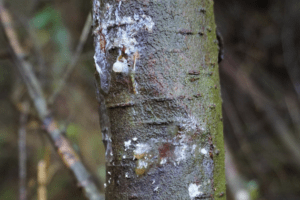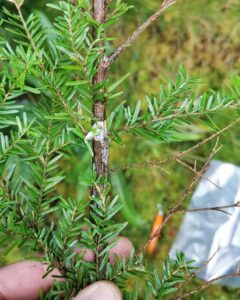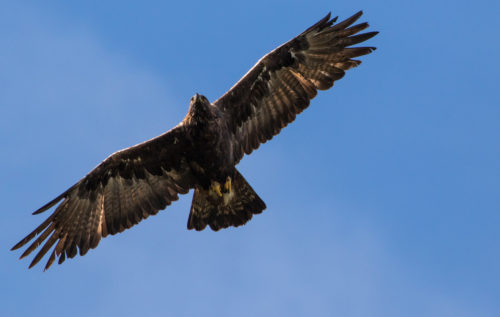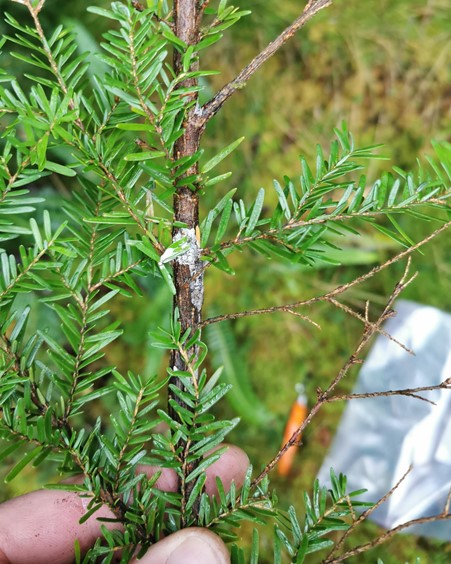An overview of Phytophthora pluvialis
Pluvialis represents the newest plant health threat to forestry in the United Kingdom having been discovered in Cornwall in September of 2021. The disease was seen to be affecting mature Douglas fir and Western hemlock.
Following this discovery further surveillance was carried out and the disease was found to have spread through Devon, Cumbria, and even to one site in the north west of Scotland. As is often the case with these diseases, by the time they are found, it can be years after they’ve first entered the country and we are then in the game of catchup to work out its actual status.
Symptoms of Phytophthora pluvialis
The symptoms of Phytophthora pluvialis are still not fully understood due to the disease only being recently discovered in the UK. Currently it is known that it can cause needle cast, shoot dieback, and lesions on the stem, branches, and roots. These symptoms are not dissimilar from what we’d look for when identifying Phytophthora ramorum in our woodlands. In the case of ramorum we would expect to see lesions form on the bark of the tree and for the tree to be oozing a dark fluid.
Understanding the impacts on forests and woodlands from Phytophthora pluvialis
The threat of pluvialis should not be understated. It has the potential to be a significant threat to our woodlands across the country. The UK Plant Health Risk Register (which is a fantastic tool for researching pests and diseases) helps us understand the threats of this disease a little more.
The register breaks out the threat of the disease into a mitigated and unmitigated scenario which allows us to understand how the impacts of proactive forest management and effective policy decisions can slow the spread and decrease the effects of the disease.
If we first look at the unmitigated scenario, we notice that the risk of entry and establishment have increased. However, these are somewhat redundant markers now as we know the disease has already entered and become established in the UK. The impact of Phytophthora pluvialis is measured through a triad of factors, economic, environmental, and social. This seeks to encompass the value trees provide in three broad strokes. Notably the social impact of Pluvialis is rated at only a ‘2’ which shows it is not viewed as a significant risk to animal or human health. The value at risk is a metric for the value of the industries at risk from this pest in the UK, here it’s shown as a ‘5’, the highest it can be. This is most likely because the disease primarily targets commercially-oriented species and would impact on the timber supply chain.
All the scores add together to give a final UK Relative Risk Rating of 60 out of 125. This demonstrates that there is a threat of this disease-causing considerable damage in the UK, but when we compare it with the mitigated UK Relative Risk Rating of 40, we can see that there is work we can do to improve the damage possible.
Action to reduce Phytophthora pluvialis
As it currently stands, the only proposed action is research, but it is likely that, as the disease begins to spread, we will see further responses coming into place including regulation in the form of SPHNs (Statutory Plant Health Notices) or publicity to alter the public’s knowledge of the disease and seek their help in identifying its spread. This is an approach that has been used numerous times with plant health concerns.
Conclusion
As Forest Managers we must continue to be observant and cautious about our approach moving forward. We know the disease targets alternative conifers including Western hemlock, Douglas fir, Radiata pine, and possibly more and we should continue to pay attention to putting the most suitable tree in the best place whilst considering pests and diseases. Choosing the most suitable tree species will alleviate stress from the tree and minimise its risk of catching any pest or disease.

Phytophthora pluvialis lesions on a tree stem Crown Copyright, courtesy Forestry Commission (Accessed: 20/12/2021), licensed under the Open Government Licence

Figure 2 Multiple resinous cankers seen on Hemlock Crown Copyright, courtesy Forestry Commission (October 2021), licensed under the Open Government Licence
Find out about Peter Roe

Interested in becoming a Forest or Harvesting Manager?
Join our graduate programme




